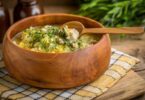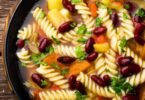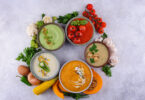Do you want to impress your guests with your cooking skills? Do you want to make your food look more appetizing and appealing? Do you want to boost your food blog traffic with stunning photos of your dishes?
If you answered yes to any of these questions, you need to learn some cooking presentation tips to take your food to the next level. Cooking presentation is the art of arranging and decorating food on a plate or a platter to enhance its visual appeal and stimulate the appetite. It’s not just about making your food look pretty but also about creating a balance of colors, textures, shapes, and flavors that complement each other and the dish.
In this blog post, I will share some easy and effective cooking presentation tips that you can use for any cuisine and occasion. Whether you’re cooking for yourself, your family, or your friends, you can use these tips to make your food look amazing and taste even better.
Tip #1: Choose the Right Plate for Your Food

One of the most essential cooking presentation tips is to choose the right plate for your food. The plate is the canvas for your food art, so you want to ensure it matches your dish’s style, color, and size. Here are some things to consider when choosing a plate:
- Plate Size: Your plate should be big enough to make your food stand out and small enough to prevent your portions from appearing too small. A general rule of thumb is to leave some space around the edges of the plate and avoid overcrowding it with too much food.
- Plate Color: Your plate color should contrast with the color of your food so that your food pops and draws attention. For example, if you’re serving a bright green salad, you can use a white or black plate to make it stand out. You can use a light-colored plate to create contrast if you’re serving a dark brown stew.
- Plate Shape: Your plate shape should suit the shape of your food and the style of your dish. For example, if you’re serving a round pizza, you can use a round plate to match it. If you’re serving a rectangular lasagna, you can use a rectangular plate to fit it. If you’re serving a rustic dish, you can use a wooden board or a metal tray to add some character.
Tip #2: Cut and Arrange Your Food in an Interesting Way

Another cooking presentation tip is to cut and arrange your food interestingly. Cutting and putting your food can make a big difference in how your food looks and tastes. Here are some ways to trim and arrange your food:
- Cut Your Food Horizontally: Cutting your food horizontally can create height and layers on your plate, making your food look more appealing and elegant. For example, you can cut your meat horizontally and fan it out on your plate, or you can cut your cake horizontally and stack it up with some frosting or fruit in between.
- Cut Your Food into Different Shapes: Cutting your food into different shapes can add variety and fun to your plate, making your food look more playful and creative. For example, you can cut your cheese into triangles, your bread into stars, or your fruit into hearts.
- Arrange Your Food in a Pattern: Arranging your food in a pattern can create order and harmony on your plate, making your food look more organized and sophisticated. For example, you can arrange your vegetables in a spiral, your pasta in a circle, or your sushi in a grid.
Tip #3: Play with Colors and Textures on Your Plate

A third cooking presentation tip is to play with colors and textures on your plate. Colors and textures can add visual interest and excitement to your plate, making your food look more appetizing and delicious. Here are some ways to play with colors and textures on your plate:
- Use a Variety of Colors: Using a variety of colors on your plate can create a rainbow effect, making your food look more vibrant and healthy. For example, you can create a colorful salad with red tomatoes, orange carrots, yellow peppers, green lettuce, blueberries, and purple cabbage.
- Use a Variety of Textures: Using a variety of textures on your plate can create a contrast effect, making your food look more diverse and flavorful. For example, crunchy nuts, creamy cheese, soft bread, juicy fruit, and crispy bacon can create a texture-rich breakfast.
- Use a Variety of Cooking Methods: Using various cooking methods on your plate can create a balance effect, making your food look more complete and satisfying. For example, you can use grilled chicken, roasted potatoes, steamed broccoli, and sautéed mushrooms to create a balanced dinner.
Tip #4: Use Sauces and Garnishes to Enhance Your Food

A fourth cooking presentation tip is to use sauces and garnishes to enhance your food. Sauces and garnishes can add flavor and decoration to your food, which can make your food look more tasty and attractive. Here are some ways to use sauces and garnishes on your plate:
- Use Sauces as Paint for Your Plate: Using sauces as paint for your plate can create some color and movement, making your food look more artistic and dynamic. For example, you can drizzle some chocolate sauce over your ice cream or swirl some pesto sauce over your pasta.
- Use Garnishes to Enhance Your Food: Using garnishes to enhance your food can create freshness and elegance on your plate, making your food look more refined and delicious. For example, you can sprinkle some chopped parsley over your soup or place some mint leaves over your fruit salad.
Tip #5: Express Yourself and Have Fun with Your Food

A fifth and final cooking presentation tip is to express yourself and have fun with your food. Cooking presentation is not only about following rules and guidelines but also about showing your personality and creativity. Here are some ways to express yourself and have fun with your food:
- Experiment with Different Styles and Themes: Different styles and themes can help you find your cooking presentation style, making your food look more unique and original. For example, you can try a minimalist, rustic, or whimsical style for your food presentation. You can also try a seasonal, cultural, or personal theme for your food presentation.
- Use Edible Decorations and Tools: Edible decorations and tools can help you add fun and humor to your food presentation, making your food look more enjoyable and entertaining. For example, you can use cookie cutters, molds, or stamps to shape your food. You can also decorate your food with edible flowers, herbs, or sprinkles.
- Have Fun and Be Creative: Having fun and being creative can help you enjoy the process of cooking presentation, which can make your food look more lively and cheerful. For example, you can make faces, animals, or scenes with your food. You can also use your imagination and inspiration to create your own food presentation ideas.
I hope you enjoyed these cooking presentation tips and found them helpful for your food blog. Cooking presentation can make a big difference in how your food looks and tastes . So, don’t be afraid to experiment, have fun with your food presentation, and let your food shine!







